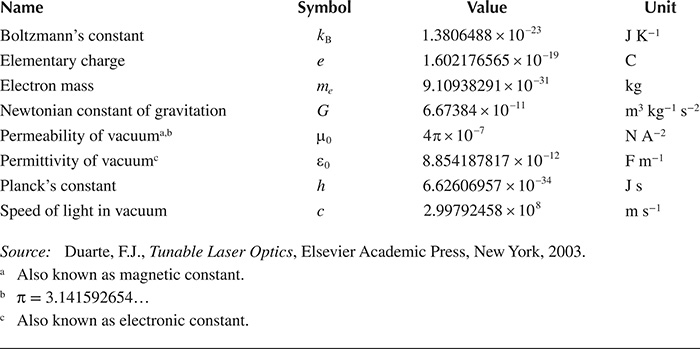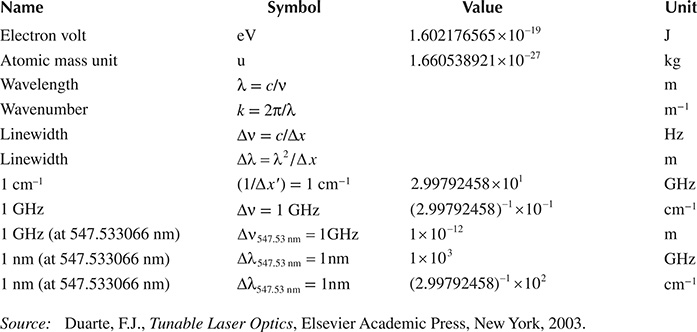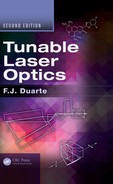13
Physical Constants and Optical Quantities
13.1 Fundamental Physical Constants
Physical constants useful in optics are listed in Table 13.1. The values of these constants are those listed by the National Institute of Science and Technology (NIST) available at the time of publication.
13.2 Conversion Quantities
Conversion quantities often used in optics are listed in Table 13.2. The conversion values for the electron volt and the atomic mass unit are the values listed by the NIST available at the time of publication.
In narrow-linewidth tunable laser design and spectroscopy, the units on linewidth and linewidth conversion units are important. From the approach to the uncertainty principle, given in Chapter 3, the following linewidth expressions are obtained:
given in meters (m), and its equivalent in the frequency domain
given in hertz (Hz). In spectroscopy, a widely used unit for linewidth is the reciprocal centimeter (cm−1) (Herzberg 1950), as indicated in Table 13.2. This spectroscopist’s linewidth follows from Equation 13.2 since
where:
the units of Δx are in meters (m)
Conversion of the linewidth to units of cm−1 can be done via the identity
so that the equivalent of Δν ≈ 30 GHz, which is (1/Δx) ≈ 100 m−1, becomes (1/Δ x c) ≈ 1 cm−1. A more specific example for the conversion of Δν ≈ 350 MHz, at λ ≈ 590 nm, is given in Table 13.3.
TABLE 13.1
Fundamental Physical Constants

TABLE 13.2
Laser Optics Conversion Quantities

TABLE 13.3
Linewidth Equivalence for Δλ ≈ 0.0004064 nm at λ ≈ 590 nm
Linewidth Domain |
Value |
Wavelength |
Δλ ≈ 0.0004064 nm at λ ≈ 590 nm |
Frequency |
Δν ≈ 350 MHz |
Spatial |
(1/Δ x′) ≈ 0.0116747 cm−1 |
Source: Duarte, F.J., Tunable Laser Applications, CRC Press, New York, 2009.
TABLE 13.4
Photon-Energy Wavelength Equivalence
Photon Energy |
Wavelength (nm)a |
1 eV |
~1239.842 |
10 eV |
~123.9842 |
100 eV |
~12.39842 |
1 keV |
~1.239842 |
10 keV |
~0.123984 |
Source: Duarte, F.J., Tunable Laser Applications, CRC Press, New York, 2009.
aUsing h = 6.62606957 × 10−34 Js and 1 eV = 1.602176565 × 10−19 J.
The conversion between photon energy in eV units and wavelength is carried out using the identity
This equivalence is given in Table 13.4 for the energy range 1 ≤E ≤ 10,000 eV.
13.3 Units of Optical Quantities
The units of optical quantities used throughout this book are listed in Table 13.5.
13.4 Dispersion Constants of Optical Materials
The Sellmeier dispersion equation applicable to various optical materials is given by
where:
λ is the wavelength at which the refractive index n is to be calculated
The constants for fused silica, SF10, calcium fluoride, and zinc selenide are given in Table 13.6. For the constants given in this table, λ is in μm units.
An important parameter is the dispersion of the prism material, or ∂n/∂λ (see Chapter 4), that can be obtained by differentiating Equation 13.6 so that
TABLE 13.5
Units of Optical Quantities

TABLE 13.6
Fundamental Physical Constants

TABLE 13.7
Refractive Index and ∂n∂T of Laser and Nonlinear Optical Materials

which can be expressed more succinctly as
where:
Thus, the second derivative can be written as
The values for n(λ), λλn, and , for various materials of interest, are given in Table 4.1.
13.5 ∂N/∂T of Laser and Optical Materials
An important parameter in the design of solid-state lasers, tunable laser oscillators, and optical systems is the ∂n/∂T factor. This is given in Table 13.7 for a collection of optical materials and gain media.
Problems
13.1 For a tunable laser emitting at the wavelength of λ = 510.00, with a line-width of Δν = 300 MHz, express this linewidth in the wavelength domain (Δλ) and also in the spatial domain (1/Δx′).
13.2 Discuss the advantages and disadvantages of expressing the laser line-width in the wavelength domain (Δλ), the frequency domain (Δν), and the spatial domain (1/Δx′).
13.3 Find the wavelength equivalence, in nanometers, of 300 keV.
13.4 Starting from Equation 13.8 show that is given by Equation 13.11.
13.5 Calculate for fused silica: n(λ), ∇λn, and , at λ = 510.554 nm.
13.6 Calculate for fused silica: n(λ), ∇λn, and , at λ = 308 nm.
